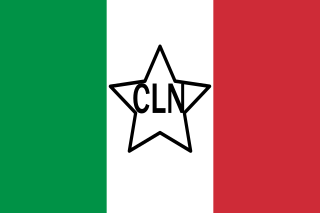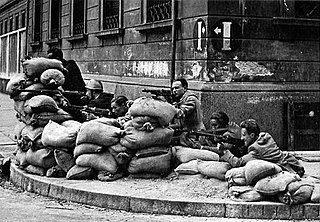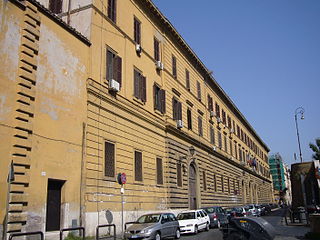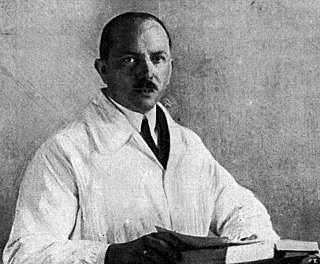
Milano Centrale is the main railway station of the city of Milan, Italy, and is the second busiest railway station in Italy for passenger flow and the largest railway station in Europe by volume.

The Italian Resistance consisted of all the Italian resistance groups who fought the occupying forces of Nazi Germany and the fascist collaborationists of the Italian Social Republic during the Second World War in Italy from 1943 to 1945. As a diverse anti-fascist and anti-nazist movement and organisation, the Resistenza opposed Nazi Germany and its Fascist puppet state regime, the Italian Social Republic, which the Germans created following the Nazi German invasion and military occupation of Italy by the Wehrmacht and the Waffen-SS from 8 September 1943 until 25 April 1945.

The Auxiliary Corps of the Black Shirts' Action Squads, most widely known as the Black Brigades, was one of the Fascist paramilitary groups, organized and run by the Republican Fascist Party operating in the Italian Social Republic, during the final years of World War II, and after the signing of the Italian Armistice in 1943. They were officially led by Alessandro Pavolini, former Minister of Culture of the fascist era during the last years of Fascist Italy.

Indro Alessandro Raffaello Schizogene Montanelli was an Italian journalist, historian, and writer. He was one of the fifty World Press Freedom Heroes according to the International Press Institute. A volunteer for the Second Italo-Ethiopian War and an admirer of Benito Mussolini's dictatorship, Montanelli had a change of heart in 1943, and joined the liberal resistance group Giustizia e Libertà but was discovered and arrested along with his wife by Nazi authorities in 1944. Sentenced to death, he was able to flee to Switzerland the day before his scheduled execution by firing squad thanks to a secret service double agent.

The Italian Civil War was a civil war in the Kingdom of Italy fought during the Italian campaign of World War II between Italian fascists and Italian partisans and, to a lesser extent, the Italian Co-belligerent Army.

Bolzano was a transit camp operated by Nazi Germany in Bolzano from 1944 to 3 May 1945 during World War II. It was one of the largest Nazi Lager on Italian soil, along with those of Fossoli, Borgo San Dalmazzo and Trieste.

Regina Coeli is the best known prison in the city of Rome. It was formerly a Catholic convent and became a prison in 1881.

The Holocaust in Italy was the persecution, deportation, and murder of Jews between 1943 and 1945 in the Italian Social Republic, the part of the Kingdom of Italy occupied by Nazi Germany after the Italian surrender on 8 September 1943, during World War II.
Storia d'Italia is a monumental work of the journalist and historian Indro Montanelli, written in collaboration with Roberto Gervaso and Mario Cervi from 1965 to 1997. The idea of a series of books about the history of Italy came to Montanelli after a conversation with Dino Buzzati. Montanelli initially proposed the idea to Mondadori, who wasn't interested. Montanelli then spoke to Longanesi, who agreed to publish the prologue, Storia di Roma in 1957. Following the success of the book, Rizzoli purchased the rights of the work and republished it in 1959. In 1965 Rizzoli, satisfied with the cultural impact of the book and its commercial success, agreed to publish the ambitious Storia d'Italia.

The Museum of the Liberation of Rome is located in an apartment building at Via Tasso 145, Rome, close to the basilica of St. John Lateran. It records the period of German occupation of Rome in the Second World War and its subsequent liberation. The building housing the museum was used by the SS to torture members of the Italian Resistance in the first half of 1944.

Theodor Emil Saevecke was an SS officer and perpetrator of the Holocaust in Poland and the Holocaust in Italy.

Ernesto Belloni was an Italian businessman, academic and politician who served as the first podestà of Milan from 1926 to 1928. In 1929 he was accused of corruption and condemned to leave his party and then to a 5-years confino. Under Belloni, the public debt of the city of Milan raised from 60 to 185 million Lire between 1926 and 1927.

The Memoriale della Shoah is a Holocaust memorial at the Milano Centrale railway station commemorating the Jewish prisoners deported from there during the Holocaust in Italy. Jewish prisoners from the San Vittore Prison, Milan, were taken from there to a secret underground platform, Platform 21, to be loaded on freight cars and taken on Holocaust trains to extermination camps, either directly or via other transit camps. Twenty trains and up to 1,200 Jewish prisoners left Milan in this fashion to be murdered, predominantly at Auschwitz.

Giorgio Pisanò was an Italian journalist, essayist and fascist politician.

Laura Conti was an Italian anti-fascist partisan, doctor, environmentalist, socialist politician, feminist, and novelist, considered one of the avant-garde figures of Italian environmentalism.

Tullio Farabola was an Italian photographer.

The murder of Francesco Di Cataldo was committed in Milan, Italy, on 20 April 1978 by the Red Brigades.

Francesco Colombo was an Italian Fascist soldier and policeman, founder and leader of the Legione Autonoma Mobile "Ettore Muti", an anti-partisan unit of the Italian Social Republic infamous for its atrocities.

Leopoldo Gasparotto, better known as Poldo Gasparotto was an Italian mountaineer and Resistance leader during World War II.

Piazzale Loreto massacre was a Nazi-Fascist massacre that took place in Italy, on 10 August 1944 in Piazzale Loreto, Milan, during the World War II.




















